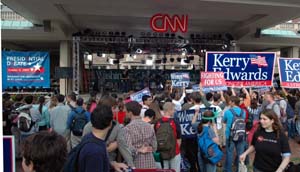A dreary, drizzling morning set the stage for more than 1,500 journalists from across the globe who traveled to the University to cover the Oct. 8 presidential debate.

Local reporters like KSDK-TV’s Leisa Zigman and the Riverfront Times’ Randall Roberts rubbed elbows in the Athletic Complex with some of the most famous faces in the media, including NBC’s Brian Williams, Candy Crowley of CNN and FOX News’ Sean Hannity of the Hannity and Colmes show.
“John Kerry is not consistent with the issues, and the president has been rock solid and leads with moral clarity,” Hannity told a group of reporters minutes before the debate.
“The media really need to start doing their job and start asking relevant, tough questions. They haven’t done their job effectively on this campaign.”
Not more than three feet from Hannity, Henry Cisneros, former secretary of Housing and Urban Development under President Bill Clinton, was offering a different opinion.
“These debates have a real advantage for the public because it lets them see the candidates in an unvarnished way — the truth of the person comes out,” Cisneros said. ” … John Kerry is very comfortable and well-schooled on the issues, and his demeanor is very presentable.”
As was the case in the presidential debates hosted by the University in 1992 and 2000, the Recreational Gym in the Athletic Complex served as the media filing center.
Behind “spin alley” — the bustling area where advocates for both parties attempt to convince the media that their candidate won the debate — reporters from international media outlets such as the Arabic-language network Al-Jazeera and the Japanese wire service Jiji sat alongside journalists from U.S. News & World Report, Chicago Tribune and The New York Times at the 18 rows of tables running the width of the gym.
“It’s really exciting to be here,” said Jiji correspondent Ken Karube, who was interested in hearing the candidates’ responses on medical issues like stem-cell research. “The campus at Washington University is really beautiful and everything is really well-organized and running smoothly.
“It’s been an incredible experience.”
More than 550 journalists watched the debate from the me-dia filing center. NBC provided pooled audio and video for ABC, CBS, CNN, FOX, C-SPAN and PBS, and offered feeds to affiliate stations worldwide. A convoy of massive satellite trucks crammed the parking lot in front of the Athletic Complex, broadcasting the event to millions of people worldwide.
|
International reporters soak up political scene By Kim Leydig Among the many international journalists who came to the University to cover the second presidential debate were broadcast representatives from the BBC, Mexican news network Televisa, the Japanese news wire Jiji and Al-Jazeera, the Arabic-language network. Televisa senior news correspondent Gregorio Meraz said the rainy weather made things a bit chaotic in the early morning of the debate, but by mid-afternoon everything seemed to be going very well. “It’s exciting to be here,” said Meraz, who is covering all three presidential debates. “Covering the war in Iraq from Baghdad was the most intense story we’ve done, but this is exciting in a different way — and it’s not nearly as dangerous!” Jiji correspondent Ken Karube added that he was looking forward to the town-hall style of this debate and to hearing provocative questions from the audience. “I’m also impressed with how beautiful Washington University is,” Karube said. “It’s been a wonderful experience. Everything has been running very smoothly.” Many of the international correspondents came from their bureaus in Washington, D.C. Other foreign journalists who traveled to the University to cover the debate included Italian newspaper Corriere della Sera, ARD German public radio and Antena 3TV from Madrid. |
Hours before the debate, the media filing center began to bustle with frenzied reporters.
Print, television, radio and Internet-based media organizations from across the world convened in the media filing room, where an exhibition of U.S. flags adorned the walls (see related story).
A sampling of the national print media on hand included the Associated Press, The Wall Street Journal, USA Today, the Houston Chronicle and The Denver Post.
In addition to the major networks, television coverage included Entertainment Tonight and local stations KMOV, KSDK, KPLR, KTVI and WUTV 22, the University’s cable affiliate.
Around 7 p.m., many of them were glued to the more than 50 television monitors in the room — but they weren’t all watching pre-debate coverage.
Many were eyeing the Boston Red Sox-Anaheim Angels baseball playoff game. A loud cheer erupted minutes before the debate, when the Red Sox nabbed an 8-6 series-clinching victory.
But all interest turned to politics when President George W. Bush and Sen. John Kerry took the stage.
Before, during and after the debate, supporters from both parties swarmed reporters whenever someone was being interviewed. They crowded behind interview subjects, vying for maximum coverage as they waved and flaunted their political placards.
According to SBC Communications Inc. and the University, 1,600 voice and data lines and 60 DSL lines were added at the Athletic Complex; 53 miles of fiber-optic cable stretched across the Hilltop Campus and 10 major power generators were used.
Other media highlights included live CNN broadcasts from Brookings Quadrangle and MSNBC’s live broadcasts of Hardball With Chris Matthews just west of Graham Chapel.
“As a local reporter who covers St. Louis every day, it’s really nice to have an opportunity to see St. Louis shine in the national spotlight,” said KSDK-TV anchor Mike Bush, who was on the Hilltop Campus to interview Matthews and NBC News’ Tom Brokaw. “It’s always exciting to be part of such a historic event.”